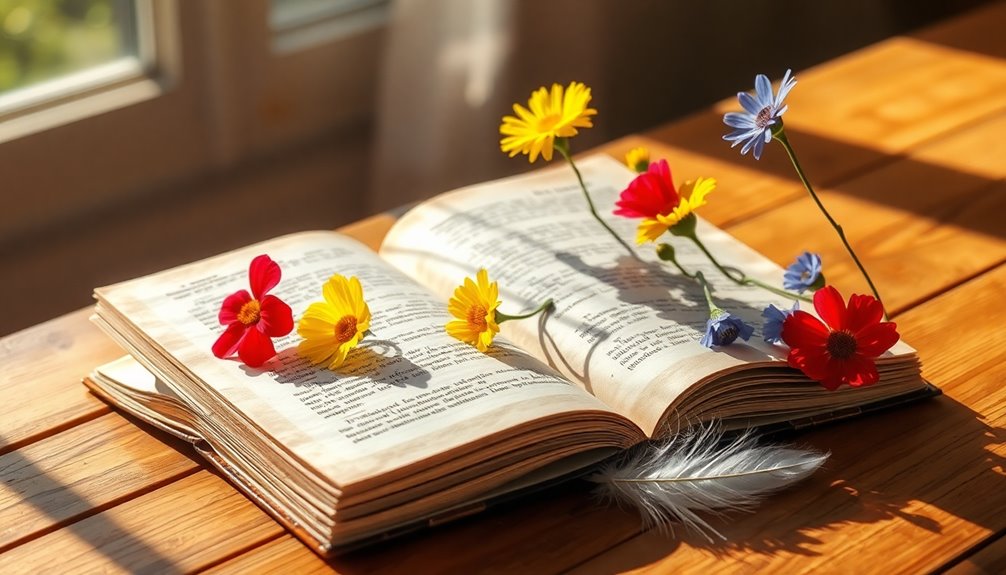Symbolism helps you uncover deeper meanings in stories, making your reading experience more exciting and engaging! When you notice symbols, like a mockingbird representing innocence, you start to connect with the characters and their feelings. This encourages you to think critically about themes and emotions, turning you into an active participant in the tale. Plus, understanding symbols can enhance your overall enjoyment and connection to the story. You might discover that symbols relate to your own experiences too! So, keep an eye out for those special meanings, and you might just find more surprises waiting for you along the way!
Key Takeaways
- Symbolism enriches narratives by adding layers of meaning, prompting readers to engage more deeply with the text.
- Recognizing symbols fosters critical thinking, allowing readers to explore complex themes and emotional connections within the story.
- Symbols evoke emotional responses, strengthening connections to characters and enhancing reader empathy and understanding.
- Engaging with symbols encourages active participation, making the reading experience more interactive and relatable.
- Understanding cultural and contextual symbols deepens comprehension and enjoyment, revealing hidden meanings tied to specific narratives.
Understanding the Role of Symbolism

Understanding the role of symbolism in literature can greatly enhance your reading experience. Symbolism adds layers of meaning to stories, making them richer and more interesting. When you read, you might notice objects, actions, or characters that represent bigger ideas. This powerful tool helps authors communicate emotions and concepts without saying everything outright.
For example, a red rose might symbolize love, while a storm could represent conflict. By recognizing these symbols, you can engage with the story on a deeper level. It's like uncovering hidden treasures in the text! You'll find that symbolism invites you to think and analyze, sparking your curiosity about what everything means.
Moreover, writers often use universal symbols that connect with shared cultural meanings. This connection helps you relate to the story more personally, making it feel as if the characters' experiences reflect your own.
When symbolism ties different plot elements together, it creates a sense of unity, making the entire narrative more cohesive. So, as you immerse yourself in your next book, pay attention to the symbols. You'll discover a whole new layer of enjoyment and understanding waiting for you!
Enhancing Reader Engagement

Symbolism can transform your reading experience by actively drawing you into the narrative. When you encounter symbols, they add depth and excitement to the story. These symbols can stand for complex ideas without boring explanations, making it easier for you to dive right into the action. Instead of just reading, you become a part of the adventure!
As you explore the meaning within the symbols, you start to feel stronger connections to the characters and themes. For example, a simple red rose might symbolize love, making you think about the characters' feelings and relationships. This emotional response keeps you engaged and wanting to know more.
Moreover, the interplay of symbols encourages you to participate actively in the story. You're not just a passive reader anymore; you're an interpreter, seeking to uncover the hidden messages. This interactive experience enhances your reader engagement, creating multiple paths for exploration.
Layers of Meaning in Texts

When you read a story, you might notice that some objects or characters mean more than they seem.
These symbols add exciting layers of meaning, making the narrative deeper and richer.
Enhancing Narrative Depth
Diving into a narrative rich with symbolism opens up a world of deeper meaning that goes far beyond the plot. When you explore the symbols in a story, you'll find layers of depth that invite you to think and feel more. Symbols can represent big ideas, emotions, or societal issues, making the narrative resonate with you.
Here are three ways symbolism enhances your reading experience:
- Complex Themes: Symbols help express complex themes subtly, making you ponder their significance.
- Emotional Connections: They evoke feelings, linking your personal experiences to the story and making it memorable.
- Cohesive Messages: The interplay between symbols and themes encourages you to see how different elements connect, creating a unified meaning.
As you uncover these layers, you'll discover that the narrative isn't just about what happens. It's also about what it means. Engaging with symbols allows you to dive deeper into the story, enriching your understanding and making your reading journey even more exciting.
Engaging Reader Interpretation
How can a simple image or object transform your understanding of a story? When you immerse yourself in a text filled with symbolism, you uncover deeper meanings that might surprise you. Each symbol, whether it's a flower, a color, or an object, invites you to engage with the story on a whole new level.
Authors cleverly use these symbols to hint at complex themes, allowing you to explore personal connections and insights. Imagine discovering that a red rose in a tale isn't just pretty; it might represent love, passion, or even danger.
By interpreting these symbols, you start to think critically about the broader issues in the story, like friendship, loss, or courage. This deeper engagement makes reading not only more enjoyable but also more meaningful. In the same way that utilitarian thinkers advocate for actions that maximize overall well-being, symbols can enhance your understanding of characters' motivations and conflicts.
As you notice symbols and their themes, you might feel strong emotions, making your reading experience even more memorable. So, next time you read, pay attention to the symbols! They can guide you to a richer understanding of the story, opening doors to new interpretations and ideas that spark your imagination.
Happy reading!
Symbolism in Character Development

In literature, symbolism plays an essential role in character development, revealing the intricate layers of individuals' experiences and emotions. Symbols in fiction can help you understand characters better, making their journeys more relatable. Personal symbols reflect a character's past and their emotional states, giving you deeper insight into their motivations.
Here are three ways personal symbols enhance character development:
- Reflect Individual Experiences: Objects tied to characters can bring back memories, showing you their past traumas or joys.
- Illustrate Growth: Personal symbols often indicate a character's transformation throughout the story, revealing how they evolve.
- Show Complex Relationships: Symbols can represent the connections between characters, helping you grasp the nuances of their interactions.
When you recognize these symbols, they can trigger emotional responses, fostering empathy as you connect with the character's struggles and triumphs. Additionally, understanding the characters' journeys can be enriched by elements of attachment theory, which highlights how secure attachment bonds influence relational dynamics and personal growth.
Emotional Resonance Through Symbols

Symbols not only enhance character development but also evoke deep emotional responses that resonate with readers. When you connect with symbols in a story, they help you feel what characters feel. For example, a scar might remind you of pain or trauma. The mockingbird in *To Kill a Mockingbird* symbolizes innocence and loss. This connection makes the story even more powerful and emotional.
Here's a look at some common symbols and their emotional impacts:
| Symbol | Emotional Resonance |
|---|---|
| Mockingbird | Innocence and loss |
| Withering flower | Fading hope |
| Heart | Love and affection |
| Broken chain | Freedom and liberation |
| Dark cloud | Sadness and despair |
These universal symbols and their vivid mental associations can really deepen your connection to the story. They remind you of your own experiences, making the narrative stick in your mind. Each symbol carries its weight, helping to create a rich emotional tapestry that you can relate to. So, the next time you read, pay attention to these symbols—they can reveal feelings you didn't even know you had!
Identifying Symbols in Literature

Literature is rich with layers of meaning, and identifying symbols is essential to uncovering these depths. When you read a story, look for objects, actions, or characters that hold more significance than their surface meaning. Engaging with these symbols helps you connect emotionally and intellectually with the narrative.
Here are three tips to help you identify symbols:
- Look for recurring symbols: If you notice certain images or themes appearing multiple times, they often carry special meaning related to the story's bigger ideas.
- Consider context: Understanding the cultural, historical, and emotional background of a symbol can greatly enhance your interpretation. This context can reveal why the author chose specific symbols.
- Analyze character associations: Pay attention to how characters interact with symbols. Their relationships with these symbols can provide insight into their growth and the story's deeper messages.
Cultural Context and Symbolism

Understanding how cultural context shapes symbolism can deepen your reading experience. When you read, knowing the cultural background of symbols can change everything! Symbols might mean different things in various societies or time periods, which impacts your interpretation. For example, a harp in Irish culture stands for national pride, while in Greco-Roman traditions, it represents wisdom.
Here's a quick look at how different cultural contexts influence symbolism:
| Culture | Symbol |
|---|---|
| Irish | Harp (national pride) |
| Greco-Roman | Harp (wisdom) |
| Native American | Eagle (freedom) |
| Japanese | Cherry Blossom (transience) |
When you recognize these meanings, your reader engagement increases! You'll catch subtleties that others might miss. Plus, cultural symbolism can connect readers from different backgrounds, helping everyone understand shared human experiences and values. By diving into the cultural context of symbols, you not only enhance your comprehension but also enjoy a richer and more joyful reading adventure! So next time you encounter a symbol, think about its cultural significance, and watch your understanding blossom!
Universal vs. Contextual Symbols

Let's explore the exciting world of symbols!
Universal symbols, like water representing life, can connect us all, no matter where we come from. Additionally, the power of subconscious influence can enhance our understanding of how symbols resonate within us on a deeper level. For example, many cultures view certain monsters as archetypal figures that embody humanity's fears and hopes. Furthermore, the symbolism of spiritual alchemy illustrates the transformative journey towards enlightenment, enriching our perception of universal symbols.
Meanwhile, contextual symbols are special to the stories they belong to, giving us deeper meanings tied to the characters and settings, making every reading experience unique and fun! For instance, a symbol like the Lion of Judah can evoke themes of strength and resilience within certain narratives.
Universal Symbol Recognition
Symbolism plays an essential role in how you engage with a story, as it can bridge the gap between your experiences and the narrative's themes. Universal symbols are powerful because they've meanings that many people recognize. For example, water often represents life and rebirth across cultures.
When you spot these symbols, it can stir strong emotional responses within you. This connection creates layers of meaning that enhance your reading experience.
Here are three key reasons why universal symbol recognition matters:
- Accessibility: Universal symbols make it easier for you to understand the story, no matter your background.
- Shared Experiences: They tap into common feelings and memories, drawing you into the narrative.
- Emotional Depth: Recognizing these symbols can deepen your emotional connection to the characters and themes.
Contextual Symbol Interpretation
Symbols can profoundly shape your reading experience, particularly when you distinguish between universal and contextual symbols. Universal symbols, like water symbolizing life, are easy to recognize across cultures. They help you connect with big ideas.
However, contextual symbols are special. These symbols are tied to a specific story, like a character named Lily who finds a lost key that represents her journey to reveal her true self.
Understanding contextual symbols adds depth to your reading. These symbols help you dive deeper into the characters and the plot.
For example, when you know what a certain object means in the story's setting, you grasp the emotions and themes better. It's like uncovering hidden treasures in the writing process!
Cultural Significance in Symbols
Understanding the cultural significance of symbols enriches your reading experience by highlighting the differences between universal and contextual meanings. When you explore these symbols, you uncover layers that make the story even more engaging.
Here are three key points to reflect on:
- Universal Symbols: These symbols, like water representing life, have meanings that people across different cultures recognize. They connect you to themes that resonate globally.
- Contextual Symbols: These are specific to a story's setting or culture. They add depth and insight into characters and themes, helping you grasp the narrative better.
- Color Symbolism: Colors can have different meanings depending on cultural backgrounds. For instance, white symbolizes purity in Western cultures, while red signifies purity in India. This variation shows how cultural significance can influence your understanding of a narrative.
Examples of Symbolism in Literature

Throughout literature, various objects and elements serve as powerful symbols that enrich the narrative and deepen the reader's experience. For instance, in *Lord of the Flies*, Piggy's glasses symbolize the fragility of civilization and intellect. They help you explore themes of societal breakdown and the loss of reason amidst chaos.
Similarly, the green light in *The Great Gatsby* represents Gatsby's unreachable dreams. It draws you into the complex world of the American Dream's disillusionment.
In *To Kill a Mockingbird*, the mockingbird symbolizes innocence and goodness. This encourages you to reflect on the moral complexities of the characters and the society they live in.
The red A in *The Scarlet Letter* signifies not just adultery, but also resilience and personal identity, inviting you to investigate themes of sin, shame, and redemption.
Finally, in *Moby Dick*, the white whale embodies obsession and the unknowable nature of existence. This prompts you to confront bigger philosophical questions about humanity and destiny.
These examples of symbolism create layers of depth in stories, allowing you to connect with abstract ideas and feel the emotions behind them.
Resources for Writers on Symbolism

When it comes to enhancing your writing with symbolism, several invaluable resources can guide you in weaving this literary device seamlessly into your narratives.
These tools can make your creative writing shine!
- One Stop for Writers: Check out their Theme and Symbolism Thesaurus. It offers a fantastic collection of symbols to deepen your storytelling and character development.
- Domestika Courses: Immerse yourself in various writing and storytelling courses that focus on the effective use of symbolism. They'll help you master this literary device in no time! Additionally, engaging in critical thinking can sharpen your ability to identify and utilize symbolism effectively. Understanding the role of mental clarity in your writing process can also enhance your creativity. Incorporating emotional resilience can help you explore deeper emotional themes through symbolism.
- Writing Prompts: Use creative writing prompts to practice incorporating symbolism into your stories. They encourage you to explore deeper themes and let your imagination run wild.
Additionally, consider seeking community feedback from platforms where you can share your work and get insights from other writers. Engaging in discussions can refine your understanding of symbolism.
Lastly, check out articles and resources dedicated to writing techniques. They can deepen your skills in symbolic writing, leading to impactful storytelling.
Moreover, understanding topical authority can significantly enhance your ability to use symbolism effectively, as it improves your overall writing credibility and engagement with readers.
With these resources at your fingertips, you're ready to bring your narratives to life with rich symbolism!
Frequently Asked Questions
How Does Symbolism Help the Audience?
Symbolism helps the audience by adding special meaning to stories. When you see a symbol, it can make you feel more connected to the characters and their journeys.
It's like finding hidden treasures in a book! Symbols also relate to bigger ideas in our world, prompting you to think about your own life.
Plus, they tie different parts of the story together, making everything more exciting and memorable. You'll discover new layers with each read!
Why Are Symbols Important in Reading?
Did you know that over 70% of readers feel more connected to a story when they notice symbols?
Symbols are important because they help you uncover hidden meanings and deeper themes in a text. They can make you think, feel, and even question the world around you!
When you spot a symbol, you become an active participant in the story, making your reading experience more fun and exciting.
What Is the Author's Purpose of Symbolism?
When authors use symbolism, they aim to add deeper meaning to their stories. They want you to feel emotions and connect with the characters in a special way.
Symbols can represent big ideas, like love or freedom, making it easier for you to understand complex themes.
Why Is the Use of Symbolism Important?
Why's symbolism important? Imagine a world where everything's just plain and boring—yikes!
Symbolism brings stories to life! It turns everyday objects into special treasures, helping you see deeper meanings and feelings. When you spot a symbol, it's like finding a secret message!
This makes you think harder and feel more connected to the characters. Plus, it can even reflect real-life issues, which makes the story feel super relatable and exciting!
Conclusion
So, next time you plunge into a book, keep an eye out for those sneaky symbols! They're like the secret sauce that makes stories extra tasty. Without them, stories might just be plain old bread—boring and dry! Symbols give depth and excitement, making you feel and think. They turn reading into a grand adventure! So grab your magnifying glass and start hunting for hidden meanings. Who knows? You might just find a treasure chest of ideas waiting for you!











